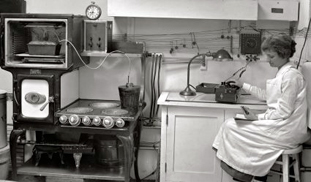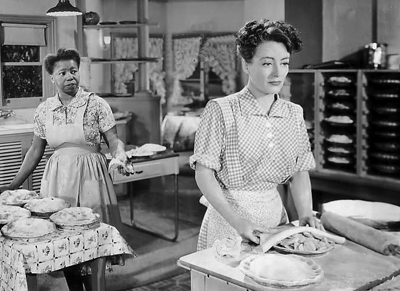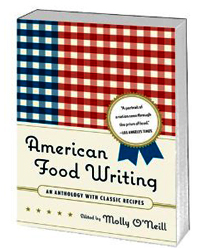 A few lines in a recent “Quick Takes” column at Inside Higher Ed were enough to make me put down the faux-croissant I’d just purchased at my school’s café and seek out the full story in The Boston Globe: the most popular class at Harvard right now is “Science of the Physical Universe 27.” It has another name as well—“Science and Cooking: From Haute Cuisine to Soft Matter Science”—and it “uses the culinary arts as a way to explore phases of matter, electrostatics, and other scientific concepts” (Devra First, “Harvard Uses Top Chefs to Spice Up Science,” Nov. 2, 2010). One interesting fact about this course is that it isn’t your mother’s or your home ec class: it has a guest list of top chefs. Another interesting fact is that 700 students tried to sign up for the fall semester’s offering.
A few lines in a recent “Quick Takes” column at Inside Higher Ed were enough to make me put down the faux-croissant I’d just purchased at my school’s café and seek out the full story in The Boston Globe: the most popular class at Harvard right now is “Science of the Physical Universe 27.” It has another name as well—“Science and Cooking: From Haute Cuisine to Soft Matter Science”—and it “uses the culinary arts as a way to explore phases of matter, electrostatics, and other scientific concepts” (Devra First, “Harvard Uses Top Chefs to Spice Up Science,” Nov. 2, 2010). One interesting fact about this course is that it isn’t your mother’s or your home ec class: it has a guest list of top chefs. Another interesting fact is that 700 students tried to sign up for the fall semester’s offering.
Seven hundred! That’s the total enrollment at some small formerly-known-as-liberal-arts-colleges. I began to think about the potential here: Why stop at physics? Why not use food to teach film and literature? Perhaps this is just what the flailing liberal arts need.
There is even some precedent: the Chaucer course at my undergraduate school included a meal on the syllabus—a sort of medieval potluck. This meal was not an entire success: the chiffon scarf cleverly draped around Mary P.’s lady-in-waiting hat (the rubric also required costumes) unfortunately caught fire just as Donna C. reached the final stage of prepping her crepes flambé, and our ineffectual attempts to douse the flames led to Sister Georgia’s discovery that we had spiked the faux mead. However, this should not deter us from curricular innovation.
 Films offer a smorgasbord of dishes from Tortilla Soup to Chocolat. Joan Crawford’s Mildred Pierce tells us up front, “I was always in the kitchen.” Now, instead of just watching Crawford chew up the scenery, film students, for extra credit, can recreate and enjoy Mildred’s specialties: fried chicken and pie. Students taking literature classes to satisfy their core requirements might understand why Gabriel is so out of sorts in James Joyce’s The Dead if they were asked to serve up the menu for the Misses Morkan’s annual party. Incoming freshmen might be assigned the first third of Liz Gilbert’s Eat, Pray, Love (with three out of five of the best-selling nonfiction topics, this has to be the most brilliant title ever to appear on a work of nonfiction—the only things missing are money and cats). One literature course that could easily be adapted for the new Read and Cook Curriculum is the American lit survey: who doesn’t enjoy a tasty dinner of turkey, cranberries, and swan?
Films offer a smorgasbord of dishes from Tortilla Soup to Chocolat. Joan Crawford’s Mildred Pierce tells us up front, “I was always in the kitchen.” Now, instead of just watching Crawford chew up the scenery, film students, for extra credit, can recreate and enjoy Mildred’s specialties: fried chicken and pie. Students taking literature classes to satisfy their core requirements might understand why Gabriel is so out of sorts in James Joyce’s The Dead if they were asked to serve up the menu for the Misses Morkan’s annual party. Incoming freshmen might be assigned the first third of Liz Gilbert’s Eat, Pray, Love (with three out of five of the best-selling nonfiction topics, this has to be the most brilliant title ever to appear on a work of nonfiction—the only things missing are money and cats). One literature course that could easily be adapted for the new Read and Cook Curriculum is the American lit survey: who doesn’t enjoy a tasty dinner of turkey, cranberries, and swan?

Advanced students may want to follow up with a hearty course of study based on American Food Writing: An Anthology: With Classic Recipes
, edited by Molly O’Neill (The Library of America, 2007, 2009). This book not only includes menus and philosophical musings from luminaries whom you’d expect to find— such as James Beard, M.F.K. Fisher, and Michael Pollan (and Alice B. Toklas)—but it also serves up two entries by Thoreau, one on bread and another on watermelon (there is no mention of his confession in Walden that he was sometimes “tempted to seize and devour” a woodchuck), along with Thomas Jefferson’s recipe for ice cream. Walt Whitman is here too (more ice cream—the perfect dish for those summer days spent loafing on the lawn and observing spears of grass). For history majors, there’s John Thorne’s discourse on “The Toll House Cookie.”
And for their senior project, students may want to investigate, if not actually sample, the excerpts from Cross Creek Cookery, in which Marjorie Kinnan Rawlings, author of the heartbreaking The Yearling, serves up considerably tougher recipes for “Pot Roast of Bear” and “Alligator-Tail Steak.” In fact, it might be a good idea to feature Rawlings on the syllabus: she offers just the spirit of imaginative adventure we need in both the kitchen and the classroom.
Carolyn Foster Segal teaches creative writing at Cedar Crest College and is a contributor to the Observer column of The Chronicle of Higher Ed.

